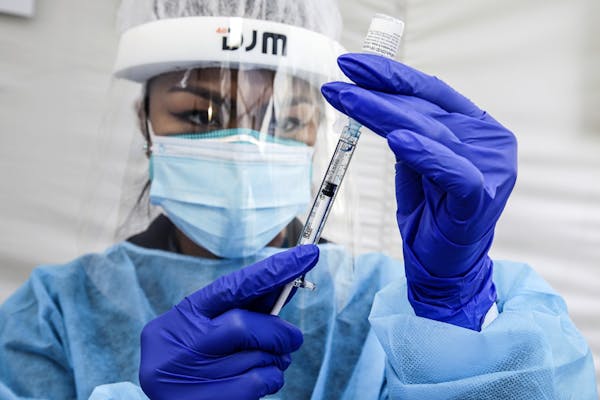More than 800,000 infections with the coronavirus that causes COVID-19 have been reported in Minnesota, which saw two key indicators of pandemic severity increase Tuesday after some hopeful declines last month.
COVID-19 hospitalizations in Minnesota increased Monday to 978 — seesawing between a recent high of 1,008 on Oct. 15 and a low of 907 on Oct. 22 — while the state's reported positivity rate of diagnostic testing increased to 7.9%.
Gov. Tim Walz on Tuesday announced the opening of a temporary alternative care site to relieve pressure on hospitals by taking patients who are ready to be discharged from inpatient beds but still need transitional care. Benedictine St. Gertrude's in Shakopee will take up to 30 patients from area hospitals, using an emergency staffing pool of eight nurses and four nursing assistants along with specially trained members of the Minnesota National Guard.
"This is an all-hands-on-deck moment for our hospitals," Walz said. "We are answering the call from Minnesota's doctors and nurses, who are asking for support and relief as they treat critically ill COVID-19 patients."
State health officials encourage unvaccinated people to seek shots against COVID-19 and vaccinated people to seek booster doses when recommended, because of the persistent spread of the coronavirus.
Minnesota has the ninth-highest rate among states of coronavirus infections over the past seven days, according to the Centers for Disease Control and Prevention, as states such as Florida and Missouri at the front end of the delta variant wave have seen their numbers taper. Mayo Clinic's 14-day forecast predicts mild growth in Minnesota from 2,500 new infections per day to about 2,700 in mid-November.
"It's been really hard for us to predict where this virus is going," said Kathy Como-Sabetti, a COVID-19 epidemiology supervisor for the Minnesota Department of Health.
The state's total of 805,015 coronavirus infections and 8,718 COVID-19 deaths include 7,043 infections and 24 deaths that were verified over the weekend and newly reported on Tuesday.
Seniors make up 86% of COVID-19 deaths in Minnesota but 73% of deaths since July 1. Tuesday's additions included 17 seniors, two people in their 40s from Wadena and Itasca counties and two people in their 30s from Hennepin and Mower counties.
Nearly 3.7 million Minnesotans 12 and older — almost 77% of the state's eligible population — have received at least a first dose of COVID-19 vaccine, according to the CDC.
The federal agency also ranked Minnesota third for its number of COVID-19 booster doses, which are recommended for seniors and younger adults with underlying health problems or occupational risks for infection if they received initial Moderna or Pfizer vaccine. All recipients of the single-dose Johnson & Johnson COVID-19 vaccine are eligible for boosters.
Mayo Clinic and its data partner, nference, released encouraging results Tuesday showing that the J&J vaccine remained effective from February through July this year — though the results were mostly before the spread of the delta variant responsible for the latest pandemic wave.
Comparing 8,889 of Mayo's vaccinated patients and 88,898 unvaccinated patients, the study found that the vaccine was 73.6% effective and produced a 3.7-fold reduction in infections. Most real-world research has been done with the Moderna and Pfizer versions, which were approved earlier and used most often. Less than 5% of the doses provided in Minnesota have been J&J vaccine.
"It's good to see that, when you go from a very controlled clinical trial environment into the real world, you are seeing similar effectiveness," said Tyler Wagner, nference's vice president of biomedical research.
Bloomington-based HealthPartners also contributed to a study published by the CDC on Tuesday showing that the Pfizer and Moderna vaccines weren't as effective in people with compromised immune systems — who as a result should receive three initial doses and a booster dose six months later.
Jeremy Olson • 612-673-7744
Carolyn Parnell, 'trailblazer' who served as Minnesota's first IT commissioner, dies

